Chapter 10 PDF

| Title | Chapter 10 |
|---|---|
| Course | Leadership in Organizations |
| Institution | California State University San Marcos |
| Pages | 5 |
| File Size | 116.9 KB |
| File Type | |
| Total Downloads | 81 |
| Total Views | 175 |
Summary
Chapter 10...
Description
MGMT 452 Chapter 10: Groups, Teams, and Their Leadership
What leaders do depends on where a team is in its development Group perspective – how different group characteristics can affect relationships both with leader and followers Differences Between Groups and Teams Team members have stronger sense of identification among themselves than group members do Teams have common goals or tasks Task interdependence typically is greater with teams than with groups Teams have more differentiated and specialized roles Group – two or more persons interacting with one another to influence and be influenced Reciprocal influence; an individual is not constrained to one group Differences Between Organizations and Groups An organization can be so large that most members do not know most of the other people within it Groups are small and immediate enough to impact both feelings and self image People tend to be more psychologically invested with groups to which they belong Certain psychological needs are better satisfied by groups Six Basic Concepts For Understanding Group Perspective Group size Stages of group development Roles Norms Communication Cohesion Group Size Cliques – subgroups of individuals who often share same goals, values, and expectations o Have more influence over individuals Leader’s behavioral style and span of control o Large span of control directive, impersonal, less time with individuals o Small span of control display more consideration, personal Leader emergence is partly a function of group size with large group, a leader will most likely emerge As groups become larger, cliques are more likely to form, and many intergroup conflicts are the result of cliques Group size can affect a leader’s behavioral style span of control Group size affects group effectiveness o Additive task – group’s output involves combination of individual outputs o Process loss – inefficiencies created by more and more people working together o Social loafing – reduced effort by people when they are not individually accountable for their work o Social facilitation – working in presence of others may increase effort or productivity o Coordinating and communication Developmental Stages of Groups Forming Storming Norming Performing
MGMT 452 Chapter 10: Groups, Teams, and Their Leadership
Forming – groups are starting to get to know each other, low trust, reject emerging potential leaders with negative characteristics Storming – intragroup conflict, heightened emotional levels, status differentiation, leadership roles, building alliances Norming – group becomes more cohesive, clear emergence of leader o Understand and consider group behaviors Performing – actual works gets done at this point, functional Most groups start out leaderless Punctuated equilibrium Project teams Not as linear as the development stages of groups (see above) Spend first half coming up with ideas and strategies “Mid-life crisis” happens and they begin reexamining strategies to complete work Group roles – sets of expected behaviors associated with particular jobs/positions Task Roles in groups Initiating – defining the problem, suggesting activities, and assigning tasks Information seeking – asking questions and seeking relevant data or views Information sharing – providing data and offering opinions Summarizing – reviewing and integrating others’ points, checking for common understanding and readiness for action Evaluating – assessing validity of assumptions, quality of information, and reasonableness of recommendations Guiding – keeping group on track Relationship roles in groups Harmonizing – resolving interpersonal conflicts and reducing tension Encouraging – supporting and praising others, showing appreciation for others’ contributions, and being warm and friendly Gatekeeping – assuring even participation by all group members, making sure that everyone has a chance to be heard and that no individual dominates Role Problems Dysfunctional roles o Dominating – monopolizing group time, forcing views on others o Blocking – stubbornly obstructing and impeding group work, persistent negativism o Attacking – belittling others, creating a hostile or intimidating environment o Distracting – engaging in irrelevant behaviors, distracting others’ attention Role conflicts = receiving contradictory messages about expected behavior and affects person’s emotional well-being and performance o Intrasender role conflict – same person sends mixed signals o Intersender role conflict – someone receives inconsistent signals from several others about expected behavior o Interrole conflict – someone is unable to perform all of his roles as well as he would like o Person-role conflict – role expectations violate a person’s values o Role ambiguity – lack of clarity in expectations
MGMT 452 Chapter 10: Groups, Teams, and Their Leadership
Group norms = informal rules groups adopt to regulate and regularize group members’ behaviors Facilitate group survival Simplify expected behavior Helps group avoid embarrassing interpersonal problems Expresses central values of group and clarifies what is distinctive about group’s identity Group members should actively scan environment for opportunities that require change in operating strategy to capitalize upon them Identify behaviors that members must always do/not do to conform to group’s objectives Group cohesion = sum of forces that attracts members to a group, provides resistance to leaving it, and motivates them to be active in it keeps group together Higher cohesiveness less turnover and higher performance Why Group Cohesion Does Not Always Lead to Higher Performance A highly cohesive but unskilled team is still an unskilled team A cohesive group may develop goals that are contrary to the larger organization’s goals Overbounding – groups can become so cohesive that they erect fences and boundaries between themselves and others Group think – highly cohesive groups often become more concerned with unanimity than objectively appraising different courses of action o Symptoms of group think Illusion of invulnerability lots of risk taking Unquestioned assumption of group’s morality Collective rationalization to discount negative info/warnings Stereotypes of opposition Self-censorship from expressing ideas due to doubts about validity/importance of own ideas Illusion of unanimity Direct pressure of dissenting members Mindguards – protect group from adverse info o How to reduce group think Encourage all group members to take on role as critical evaluator Create climate of open inquiry Establish independent groups to make recommendations on same issue Have a devil’s advocate Ollieism – overzealous/loyal group members may perform illegal or unethical actions because they believe it will please their leaders Overly cohesive groups occur infrequently Effective Team Characteristics and Team Building – Center for Creative Leadership Research Clear mission and high performance standards Use resources/training to help team and assess technical skills of team members Secure resources and equipment necessary for team effectiveness Plan and organize resources to select new members/improve skills High levels of communication minimizes interpersonal conflicts
MGMT 452 Chapter 10: Groups, Teams, and Their Leadership
Organizational shells Critical factors essential for group effectiveness o Task structure – Does team know what the task is? Is it reasonable and consistent with mission? o Group boundaries – Is collective membership appropriate for task to be performed? Are there too few/many members? Do members have sufficient knowledge/skills/interpersonal skills? o Norms – Does team share set of norms? o Authority – Has team established authority? If so, are they effective? Factors may be input from industry or organizational shell level going to team/group o Too little input from these levels can decrease effectiveness o Factors are determined before work is started Ginnett’s Team Leadership Model (TLM) First identify what a team needs to be effective, and model points leader to “the way” Outputs = result of the team’s work Team is effective if output meets standards, group has ability to work together, enhances growth and personal well-being of individuals Process = how the team goes about its work Process measures o Work hard, have sufficient knowledge/skills, have strategy, and have positive and constructive group dynamics Inputs = what is available for teams as they go about their work o Individual characteristics, team factors, organizational systems Leadership Prescriptions of the Model o Creation o Dream – have a clear vision o Design – design the team o Development = ongoing work done with the team at the process level to continue to find ways to improve an already well-designed team Leverage points diagnosed after process problems found at individual, team or org level See Ginnett’s Model handout Feedback at individual level can influence perceived efficacy of individual members Information availability on which teams are doing well/struggling Simpler/easier to identify and specify the ideal type of authority, but teams seldom operate effectively under one fixed type of authority over time o Authority dynamics should change over time Ginnett’s research highly effective leaders used a variety of authority dynamics the first few minutes of the team’s life way to lay the ground for continuing expectations Concluding Thoughts About Ginnett’s Team Leadership Model Material resources Feedback loops provide information to various levels of the organization o Usually info provided to org as a whole on which teams are doing well/struggling o Feedback at individual level can influence perceived efficacy of individual members of team Leaders can influence team effectiveness by:
MGMT 452 Chapter 10: Groups, Teams, and Their Leadership
o Insuring the team has a clear sense of purpose and performance expectations o Designing or redesigning input stage variables at individual, organizational, and team design levels o Improving team performance through ongoing coaching at various stages as task is being performed Virtual Teams Geographically dispersed teams (GDTs) – also virtual teams Five major areas that need to change if global teams work o Senior management leadership o Innovative use of communication technology o Adoption of an organization design that enhances global operations o Prevalence of trust among team members o Ability to capture the strengths of diverse cultures, languages, and people Distance between members of virtual team is multi-dimensional o Geographical, organizational, temporal, and cultural distances o Psychological distance measure better than geographical distance Differences in effects that distance has on work groups are due to these variables: o Integrating practices within a virtual team o Integrating practices between a virtual team and larger host organization...
Similar Free PDFs

Chapter 10 quiz #10
- 3 Pages

Notes 10 - Chapter 10
- 5 Pages
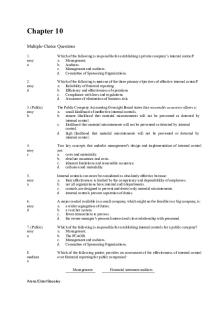
Chapter-10
- 19 Pages
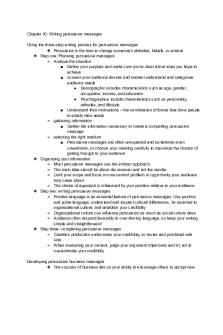
Chapter 10
- 5 Pages
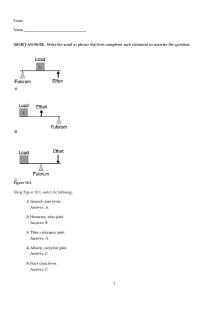
Chapter 10
- 14 Pages

Chapter 10
- 111 Pages
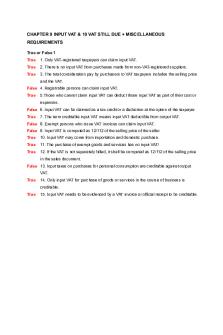
Chapter 10
- 16 Pages
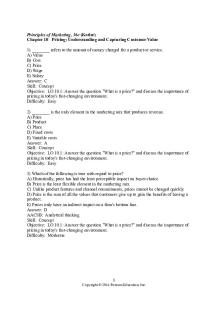
Chapter 10
- 47 Pages
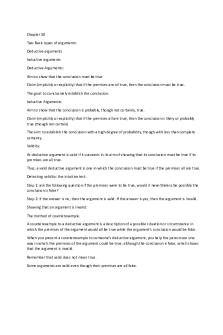
Chapter 10
- 4 Pages
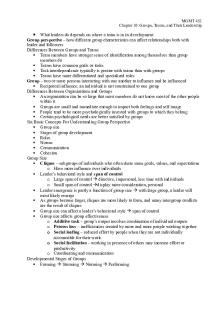
Chapter 10
- 5 Pages
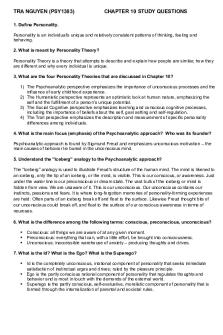
Chapter 10
- 6 Pages

Chapter 10
- 13 Pages

Chapter 10
- 10 Pages

Chapter 10
- 3 Pages

Chapter 10
- 22 Pages
Popular Institutions
- Tinajero National High School - Annex
- Politeknik Caltex Riau
- Yokohama City University
- SGT University
- University of Al-Qadisiyah
- Divine Word College of Vigan
- Techniek College Rotterdam
- Universidade de Santiago
- Universiti Teknologi MARA Cawangan Johor Kampus Pasir Gudang
- Poltekkes Kemenkes Yogyakarta
- Baguio City National High School
- Colegio san marcos
- preparatoria uno
- Centro de Bachillerato Tecnológico Industrial y de Servicios No. 107
- Dalian Maritime University
- Quang Trung Secondary School
- Colegio Tecnológico en Informática
- Corporación Regional de Educación Superior
- Grupo CEDVA
- Dar Al Uloom University
- Centro de Estudios Preuniversitarios de la Universidad Nacional de Ingeniería
- 上智大学
- Aakash International School, Nuna Majara
- San Felipe Neri Catholic School
- Kang Chiao International School - New Taipei City
- Misamis Occidental National High School
- Institución Educativa Escuela Normal Juan Ladrilleros
- Kolehiyo ng Pantukan
- Batanes State College
- Instituto Continental
- Sekolah Menengah Kejuruan Kesehatan Kaltara (Tarakan)
- Colegio de La Inmaculada Concepcion - Cebu
